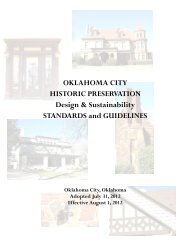OKC Plan, 2000-2020 - City of Oklahoma City
OKC Plan, 2000-2020 - City of Oklahoma City
OKC Plan, 2000-2020 - City of Oklahoma City
You also want an ePaper? Increase the reach of your titles
YUMPU automatically turns print PDFs into web optimized ePapers that Google loves.
• private investment pools,<br />
• subsidies for craftpersons practicing traditional building techniques,<br />
• Housing Replacement Tax Increment District, and<br />
• Community Housing Development Organization activities.<br />
Development and Revitalization in Historic Areas<br />
Regulations addressing development in historic areas must serve a dual purpose—preserving the<br />
historic character <strong>of</strong> each district while facilitating change that is necessary for growth. Generally,<br />
retaining the original function <strong>of</strong> a building is preferable for preserving the historic character <strong>of</strong> a<br />
building because this usually requires minimal change to the significant features <strong>of</strong> the property<br />
and/or district. Most residential buildings that retain their historic integrity should continue to be<br />
used for their original purpose. Changes to the property for the purpose <strong>of</strong> retaining the residential<br />
use in an environment <strong>of</strong> change due to adjacent new development or traffic conditions must be<br />
accommodated with sensitivity. However, in some circumstances, a change in use may be<br />
appropriate when fewer changes to the significant historic features <strong>of</strong> the building are required.<br />
Additionally, there are vacant lots within and at the edges <strong>of</strong> historic districts. The Secretary <strong>of</strong> the<br />
Interior’s Standards for Rehabilitation advises that any new construction must respect the historic<br />
character <strong>of</strong> a district by creating compatible new features/structures that are differentiated from the<br />
historic fabric. In addition to new construction, adaptive use needs to be promoted as a means <strong>of</strong><br />
providing creative opportunities for facilitating appropriate mixed use, new residential and new<br />
commercial development.<br />
Directions<br />
Promote the revitalization <strong>of</strong> historic areas by encouraging appropriate infill development.<br />
Encourage appropriate mixed-use development for historic properties.<br />
Encourage appropriate new uses that require minimal change to the significant historic features<br />
<strong>of</strong> a property.<br />
Retain the vitality <strong>of</strong> existing residential uses at the edges <strong>of</strong> residential historic districts by<br />
accommodating location-specific property alterations that respond to new development and<br />
changing traffic patterns at the perimeter <strong>of</strong> the districts.<br />
Actions<br />
Develop design guidelines for individual neighborhoods based on the unique, character-defining<br />
features <strong>of</strong> each district within a framework <strong>of</strong> basic guidelines adopted by the <strong>City</strong>.<br />
Encourage conversion <strong>of</strong> unused parts (or all) <strong>of</strong> historic non-residential buildings for residential<br />
use, in order to extend economic vitality <strong>of</strong> properties and to increase housing stock.<br />
Consider limited conversion <strong>of</strong> selected residential buildings to commercial uses including home<br />
businesses and conversion <strong>of</strong> residences facing busy thoroughfares.<br />
74

















